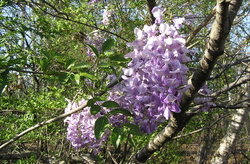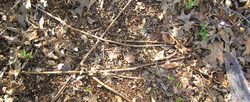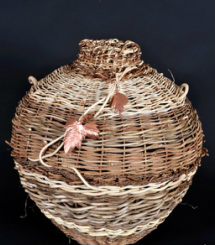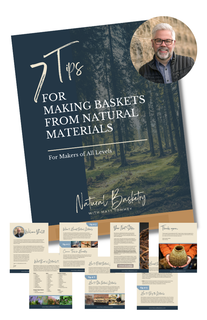 Wisteria is a great ornamental plant that can be trained and used for basketry. It’s runners have been known to run 50 feet or more when given an unobstructed area like a yard or wooded area nest to where it’s planted. Many people grow wisteria as a trellis plant and let the runners get very long each year and then harvest them at the end of the season (like honeysuckle, bougainvillea, confederate jasmine and other ornamental vines._ Harvest in the winter time as with other vines because the sap is down, although summertime harvesting for wisteria is not out of the questions, since most of the time it’s long, straight runners don’t have any leaves. For example, the place I get most of my wisteria for the year is a man’s house who lives close to me - his wisteria runners run under his deck and have none - ZERO - leaves in the summer. The runners grow about 20-40 feet in length and there are hundreds.  OK, so when you get them home, I’d recommend coiling and drying the vines. You can, however weave wisteria green because it’s such a woody vine, yet very flexible, there’s almost no shrinkage. If you want to boil it know that the bark will come off usually. HOWEVER, the bark, especially on the runners that are pencil to finger thickness is excellent for cordage and fine twining - kind of like honeysuckle bark but MUCH better. It’s actually akin more to kudzu bark, in that it stays together in one long strand much easier than does honeysuckle.  An early wisteria basket An early wisteria basket You can twine with wisteria very nicely or you can use it in random weaving which is what I use it for alot. The larger wisteria you can split like kudzu, by taking a knife to the end and making a vertical incision down the center of the vine. Pull evenly and hold the vine between your knees as you split. If it starts getting off center, simply pull to the fatter side as you split until it evens back up OR just re-clip it again with your sharp garden clippers or knife. Wisteria without the bark dries a very nice ivory white and very smooth. With the bark, it’s a beige color. Of you’re planning to plant Wisteria around your house or condo, just make sure you’re ready to keep an eye on it during the growing months and train it where you want it to go. Otherwise you will have a beast on your hands - and PLENTY of weaving material.  7 Tips for Making Baskets from Natural Materials 7 Tips for Making Baskets from Natural Materials For more information on Natural Basketry, visit http://www.matttommey.com/basket-weaving-classes.html and download my free PDF called "7 Tips for Making Baskets with Natural Materials". Inside I'll tell you what materials are good for making baskets, when to harvest, how to store and protect them, and even common tools used in the harvesting process.
11 Comments
1/4/2014 04:52:53 am
I just picked up your book, 'Unlocking the Hearts....' Praise God for your insight. I am excited about finishing the book and how my art will be changed by your words of encouragement and how you have connected my God given creativity with biblical passages. Will you be in the Cincinnati area in the coming year? I would love to hear your thoughts.
Reply
Terri McKenna
2/20/2014 03:12:54 pm
I wonder if you ever sell your supplies, such as poplar bark, wisteria, Kudzu or mimosa bark? I live in MT and can't get any of the above listed materials. I've been weaving for 28 years and besides reed use willow, red twig dogwood and horsetail which you can find here in MT.
Reply
Angela
5/17/2014 09:23:07 am
Are you still looking for Wisteria? If it can be cut, coiled and mailed from SC in May, I have some available. :)
Reply
3/8/2019 07:55:23 am
Hello I am a artist in Alabama. I create handmade twig chandeliers and pendant light fixtures currently using honeysuckle. I'm interested in finding some wisteria if anyone has any available
Amy
5/19/2017 01:34:35 pm
I LOVE your baskets!! I've been wanting to make a wisteria basket, and our new place has lots of it that I want to get rid of! I read that all parts of it are toxic, except the flower petals. Do you know whether it is safe to use a wisteria basket four harvesting herbs or eggs, or whether it should only be used for non-food/decorative purposes?!
Reply
Whitney
5/5/2023 01:30:32 pm
I'm wondering about this to, was there a response regarding toxicity potential? I prefer wisteria to kudzu but wondering if I need to use kudzu for baskets storing food.
Reply
Thank you for the great tips! I've heard that in Asia they use wisteria vines to make suspension bridges too. I was thinking they would be nice to use in tandem with cattail leaves to make a coiled basket.
Reply
Elizabeth Mackison
3/29/2019 11:45:30 pm
I really love your baskets and am so inspired :)
Reply
gwen hubbard
8/17/2021 07:58:12 am
how to dye wisteria vine with stain
Reply
Annalisa
1/19/2023 07:05:11 am
I clean out vacant urban lots in York, Pennsylvania and create urban community gardens. Saying that these lots have been abandoned under garbage and weeds for half a century would not be exaggerating. My latest site has an immensely overgrown wisteria vine that is caught up in a fallen down building. I'm planning on having a local "come make a wreath day" just to get rid of this stuff simply and quickly. Looking forward to making beauty out of immense overgrowth!
Reply
Juliet Skonberg
3/10/2024 07:13:08 pm
Following and keen to learn more, especially any in-person classes you may schedule.
Reply
Leave a Reply. |
AuthorMatt Tommey is a leader in the contemporary basketry movement and has been a maker for over 25 years. The focus of his work centers around the use of southern invasive plant species in basketry. He has served on the board of directors for the National Basketry Organization and taught at Arrowmont, the John C. Campbell Folk School and other locations both in the US and internationally. |
Mailing Address: PO Box 1382 Lindale, Texas 75771
Studio Address:Private By Appointment Only
(404) 538-5173.

 RSS Feed
RSS Feed